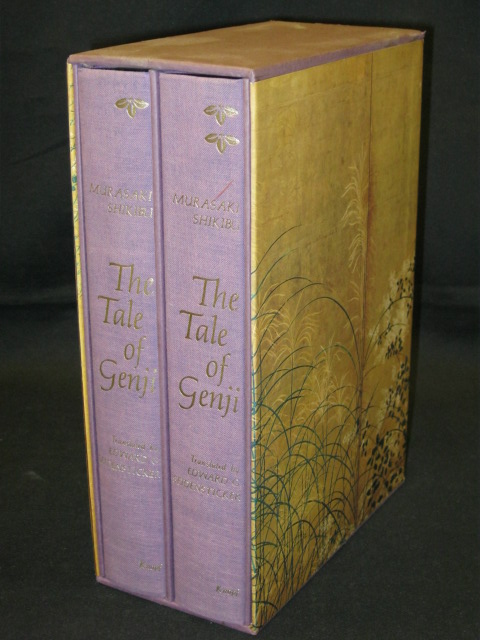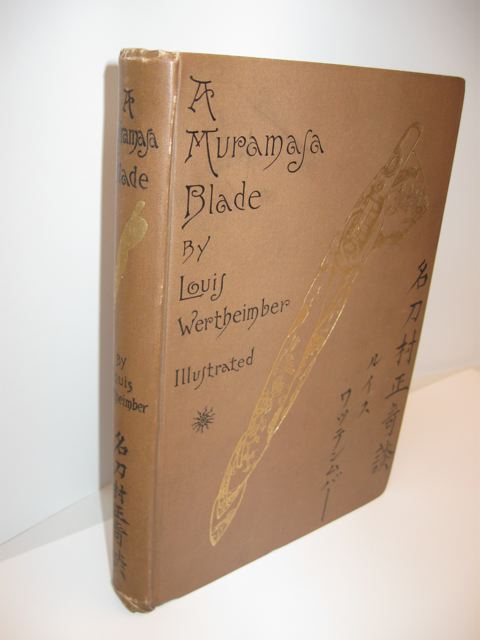|
THE TALE OF
GENJI
by Lady Murasaki, 1935, $40.00.
Translated from the Japanese by Arthur Waley.
In the early eleventh century Murasaki Shikibu, a lady in the Heian court of Japan, wrote what many consider to be the world’s first novel, more than three centuries before Chaucer. The Heian era (794—1185) is recognized as one of the very greatest periods in Japanese literature, and The Tale of Genji is not only the unquestioned prose masterpiece of that period but also the most lively and absorbing account we have of the intricate, exquisite, highly ordered court culture that made such a masterpiece possible.
Genji is the favorite son of the emperor but also a man of dangerously passionate impulses. In his highly refined world, where every flirtation is an act of political consequence, his shifting alliances and secret love affairs create great turmoil and very nearly destroy him.
In good condition, 743 pages, 5 1/2" x 8 1/4", hardcover with
slipcase |
 |
|
THE TALE OF GENJI by Murasaki Shikibu
Third Printing 1st edition
1977, $70.00.
Translated by Edward G. Seidensticker, published by Alfred A. Knopf, New York.
The Tale of Genji was written in the eleventh century by Murasaki Shikibu, a lady of the Heian court. It is universally recognized as the greatest masterpiece of Japanese prose narrative, perhaps the earliest true novel in the history of the world. Until now there has been no translation that is both complete and scrupulously faithful to the original text. Edward Seidensticker’s translation of Lady Murasaki’s splendid romance has been honored throughout the English-speaking world for its fluency, scholarly depth, and deep literary tact and sensitivity. It is illustrated throughout by woodcuts taken from a 1650 Japanese edition of The Tale of Genji.
The classical novel of court life in tenth and eleventh-century Japan centers on the life and loves of a nobleman known as the shining Genji, son of an emperor, and those of Kaoru, grandson of Genji's best friend.
In near-fine condition, 1st and 2nd books 1090 pages, 6 1/4" x 9 1/4" hardcovers with slipcase |
 |
|
THE LAST SHOGUN
The Life of Tokugawa Yoshinobu
by Ryotaro Shiba, Translated by Juliet Winters Carpenter
1st edition
1998, $30.00.
In Ryotaro
Shiba's account of the life of Japan's last shogun, Perry's arrival off
the coast of Japan was merely the spark that ignited the cataclysm in
store for the Japanese people and their governments. It came to its real
climax with the fall of the Tokugawa shogunate in 1868, the event which
forms the centerpiece of this book. The Meiji Restoration-as history calls
it-toppled the shogunate, and brought a seventeen-year-old boy emperor
back from the secluded Imperial Palace in Kyoto to preside over what
amounted to a political and cultural revolution. With this, Japan's
extraordinary self-modernization began in earnest. Coming to power just as
the Tokugawa regime was suffering the worst military defeat in its
history, Yoshinobu strongly suspected that the rule of the Tokugawas-the
third and longest lived of Japan's three warrior governments - was swiftly
becoming an anachronism. During a year of frenetic activity, he overhauled
the military systems, reorganized the civil administration, promoted
industrial development, and expanded foreign intercourse, with the
farsighted aim of creating a unified Japan. Alarmed by these reforms,
pro-imperial interests moved against him, precipitating the Boshin Civil
War and the final defeat of the shogunal armies. To the surprise of his
enemies, Yoshinobu capitulated. It was this surrender of authority at a
crucial point that made the transfer of sovereignty relatively peaceful.
He then retired to Mito and lived quietly for the rest of his life,
studying the new art of photography. Ennobled a prince in the new
European-style nobility of the Meiji era, he died in 1913.
In very good condition, 256 pages, 5 1/2" x 8 1/4", hardcover with clear plastic sleeve |
 |
|
MEMOIRS OF A GEISHA
by Arthur Golden, Seventeenth Printing, $30.00.
A literary sensation and runaway bestseller,
this brilliant debut novel tells with seamless authenticity and exquisite
lyricism the true confessions of one of Japan's most celebrated geisha.
Speaking to us with the wisdom of age and in a voice at once haunting and
startlingly immediate, Nitta Sayuri tells the story of her life as a
geisha. It begins in a poor fishing village in 1929, when, as a
nine-year-old girl with unusual blue-gray eyes, she is taken from her home
and sold into slavery to a renowned geisha house. We witness her
transformation as she learns the rigorous arts of the geisha: dance and
music; wearing kimono, elaborate makeup, and hair; pouring sake to reveal
just a touch of inner wrist; competing with a jealous rival for men's
solicitude and the money that goes with it. In Memoirs of a Geisha, we
enter a world where appearances are paramount; where a girl's virginity is
auctioned to the highest bidder; where women are trained to beguile the
most powerful men; and where love is scorned as illusion. It is a unique
and triumphant work of fiction—at once romantic, erotic, suspenseful—and
completely unforgettable.
1st ed/1st prtg (Stated First edition w/ no additional
printings listed) of , book is VG+ w/ a slight lean and wear to spine crown/heel.
Else, nice, tight and clean w/ no interior markings. Original price of $25.00 intact.
In very good condition,
437 pages, 6 3/4" x 9 1/2", hardcover with
dustjacket |
 |
|
A MURAMASA
BLADE
A Story of Feudalism in Old Japan
by Louis Wertheimber
(1887). NOT FOR SALE
The rarest book and possibly one of the first in English on this subject. Covers the great Muramasa swordsmith, his life, works, and history. Nicely illustrated with Japanese etchings on copper and relief (wood) engravings after Japanese originals.
This story is an
original tale of Old Japan, written almost from a Japanese point of view.
It might be translated into that language ; and, rendered in book form or
told on a street corner by one of the itinerant story-tellers, the reader
or listener would think it to accord fully with the traditions of the
period in which it is supposed to have been enacted. Whether such a
treatment will meet with approval here, it remains for the public to say.
I have adhered to it against the advice of several eminent literary
friends, to bring the story more into accord with our canons of style and
construction. From the standpoint of a Japanese, none of the incidents or
situations are in the slightest degree strained or exaggerated, and none
of the characters overdrawn. All the historical allusions are strictly
true and authentic, — as far as present knowledge on the subject goes, —
and have been carefully and painstakingly culled from native
chronicles.
In 'excellant' condition (120+ years old), 188 pages, 7
1/2" x 10 1/4" hardcover w/clear cover |
 |
|
A NET OF FIREFLIES
Japanese Haiku and Haiku Paintings
First Edition (1960) $90.00.
Translated by Harold Stewart
This beautiful
volume is an anthology of 320 Haiku. They were written over a span of five
centuries by many of Japan's foremost poets. The book itself, which is in
very fine condition is a remarkable achievement.
There are 33 paintings in the book that are reproduced in full color.
These swiftly brushed sketches, seldom seen outside Japan until this
publication, are an important facet of Haiku. There is a deeply perceptive
essay at the end of the book in which the translator explores the furthest
reaches of Haiku with an eye to its metaphysical implications. This book's
slipcase does show age related wear and rubbing but it has done a wonderful job of
keeping the book itself in perfect condition. Each page of the textblock
is a double page in that it is connected to the following page at its
outside edge.
First Edition, 180 pages, 5 3/8" x 7 7/8", Finely constructed hardcover with
slipcase |
 |





